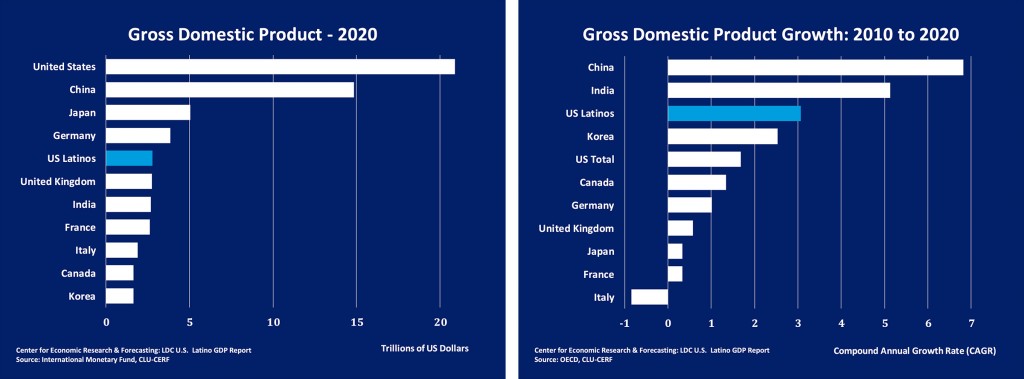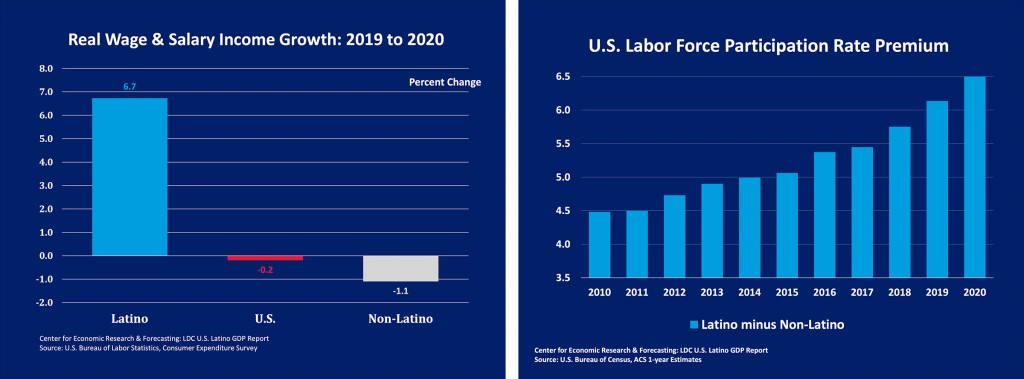CERF Blog
EXECUTIVE SUMMARY
The 2022 LDC U.S. Latino GDP Report seeks to provide a factual view of the large and rapidly growing economic contribution of Latinos living in the United States. We estimate the U.S. Latino GDP based on a detailed, bottom-up construction which leverages publicly available data from major U.S. agencies. The most recent year for which the core data is available is 2020. Thus, this year’s report provides a snapshot of the total economic contribution of U.S. Latinos in that year.
As a summary statistic for the economic performance of Latinos, the 2020 U.S. Latino GDP is extraordinary. The total economic output (or GDP) of Latinos in the United States was $2.8 trillion in 2020, up from $2.1 trillion in 2015, and $1.7 trillion in 2010. If Latinos living in the United States were an independent country, the U.S. Latino GDP would be the fifth largest GDP in the world, larger even than the GDPs of the United Kingdom, India or France.
While impressive for its size, the U.S. Latino GDP is most noteworthy for its rapid growth. From 2010 to 2020, the U.S. Latino GDP was the third fastest growing among the 10 largest GDPs, while the broader U.S. economy ranked fifth. Over that entire period, the growth of U.S. Latino GDP was 2.6 times that of Non-Latino GDP
According to the dominant narrative, Latinos as a demographic cohort should have been knocked down by the COVID-19 Pandemic. Examining the impacts of COVID-19 on Latinos through the lens of the Latino GDP reveals a very different story.In 2020, in the face of the pandemic, the strength of the U.S. Latinos was sufficient for the U.S. Latino GDP to jump three spots, beginning the pandemic as the eighth largest GDP and finishing 2020 as the fifth largest.
The performance of Latinos during the pandemic is exemplified by income data. From 2010 to 2020, Latinos enjoyed significantly higher wage and salary income growth than Non-Latinos. During those years, Latino real income grew an average of 4.3 percent per year compared to only 2.1 percent for Non-Latinos. 2020 was exceptional. Despite the extraordinary challenges presented by the pandemic, Latino real wage and salary income surged 6.7 percent. Meanwhile, Non-Latino income shrank by 1.1 percent.
Latino incomes surged due to Latinos’ tremendous work ethic during the pandemic. In 2019, prior to the onset of COVID-19, Latino labor force participation (LFP) was a record 6.1 percentage points higher than Non-Latino. By April 2020, with the onset of government-mandated shutdowns, both Latino and Non-Latino LFP saw sharp declines. Yet, it was evident from the earliest months of the pandemic that Latinos would press through each subsequent wave of disease transmission and the re-imposition of lockdowns. In each case, they returned to work with urgency. In 2020, the Latino labor force participation rate premium hit a new all-time high, when U.S. Latinos were 6.5 percentage points more likely than their Non-Latino counterparts to be actively working or seeking work.
As a result of the hard work and persistence of Latinos, Latino economic performance during the pandemic year of 2020 was strong by any comparison. In 2020, Latino real GDP did contract, however the contraction was small. Real U.S. Latino GDP contracted by 0.8 percent compared to a 4.4 contraction for Non-Latino GDP. India’s GDP contracted by 7.1 percent. France’s contracted by 8.2 percent, and the United Kingdom’s contracted by an astonishing 9.8 percent. Among the largest countries on the world stage, only China experienced stronger growth than the U.S. Latino GDP.
None of this is to make light of the hardship that Latinos endured during the pandemic. Because of a historic lack of investment in health infrastructure for Latino communities, because of their strong work ethic and unique family structure, Latinos were among the groups hardest-hit by COVID-19. This occurred despite Latinos’ superior health outcomes which prevailed in the decade prior to the pandemic. Coming out of nowhere, COVID-19 very suddenly became the number one cause of death for Latinos as opposed to only the number 3 cause of death nationally. Yet, we find that the economic data published in this report honor the sacrifices made by Latinos and illustrate just how remarkable Latino strength and resilience really is. It also highlights just how much the broader U.S. economy benefited from that strength during the pandemic. Latinos were a critical source of resilience, not just for their own families and communities, but for the U.S. economy as a whole.
Download the full report HERE



